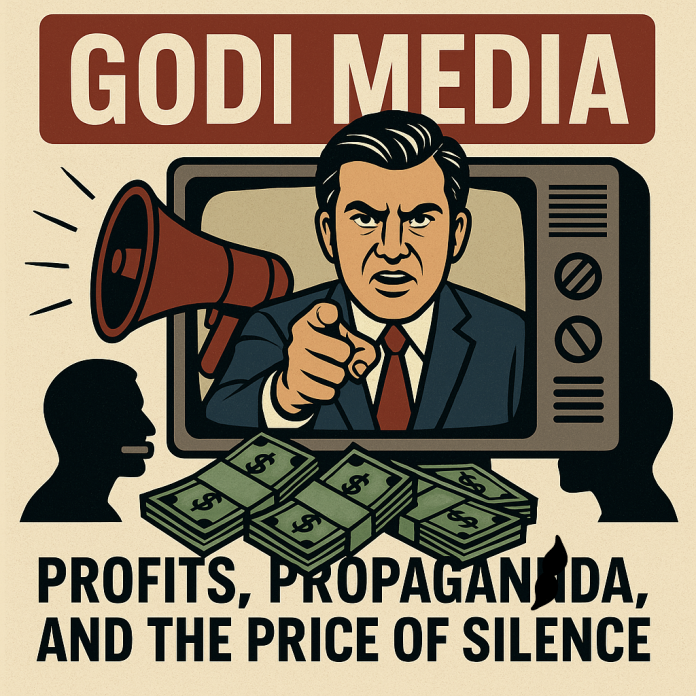A hundred and fifty years ago, newspapers were the sole source of information. With time, radio brought voices into homes, and in 1927, television transformed the news experience by adding visuals. For decades, journalism and TV were trusted as watchdogs of democracy. But in the past 10–15 years, social media and digital platforms have revolutionized the information landscape.
Despite these changes, in India, television and print still dominate public opinion. Every evening, millions of viewers sit glued to primetime debates as if it’s a daily ritual. Their influence over public perception remains unmatched, but their credibility has come under serious scrutiny.
Most TV channels and newspapers rely heavily on advertising revenue. A newspaper sold to a reader for just ₹5 actually costs between ₹25 to ₹30 to print. The shortfall is covered by advertisements—especially government ads, which are crucial for the survival of many media outlets. This economic dependency leads to self-censorship. No media house wants to bite the hand that feeds it.
To survive and thrive, media houses chase viewership and readership figures. In this race for higher TRPs (Television Rating Points), the line between journalism and propaganda is often blurred. Sensationalism and even false reporting have become the norm. During recent military tensions with Pakistan, several mainstream TV channels falsely claimed that Indian forces had captured Pakistani cities and that top Pakistani officials had fled. These were blatant lies. But the objective was clear: to whip up nationalism, boost TRPs, and attract more advertisements.
The media landscape before 2014 allowed some room to question those in power. After 2014, this space has been increasingly squeezed. Most media houses have turned into cheerleaders of the ruling establishment. Their main targets are not those in power but the opposition—especially Rahul Gandhi—and even former Prime Ministers like Jawaharlal Nehru. Real issues like unemployment, inflation, farmer suicides, and youth despair rarely find serious discussion. Instead, Hindu-Muslim debates dominate prime time, fueling communal hatred and distracting from governance failures.
This shift towards biased reporting and political servitude has given rise to the term “Godi Media” (lapdog media), now widely used to describe TV channels and newspapers that have abandoned journalistic ethics to serve those in power.
Let’s look at the numbers behind this massive propaganda machine.
In 2023, the Indian television industry generated ₹696 billion (approximately $8.4 billion) in revenue, combining both advertisement income and subscription fees. However, ad revenue fell by 6% compared to the previous year, while subscription revenues rose only by 2%.
In contrast, digital media is rapidly rising. By 2024, digital accounted for 32% of the total media revenue in India. Digital advertising grew by 17%, reaching around ₹700 billion, which made up 55% of the total advertising market.
The number of homes with smart TVs also rose—from 23 million in 2023 to 30 million in 2024, indicating a shift in how Indians consume media.
Here are the estimated annual revenues of top Indian media companies:
Sony-Zee (after merger): ₹15,056 crore
Disney-Star (includes Star Plus, Star Sports): ₹14,350 crore
Times Group (owns Times Now, ET Now, etc.): ₹8,000 crore
Viacom18 (Colors, MTV, Nickelodeon): ₹5,000–₹7,000 crore
Reliance Jio (via Viacom18 & JioCinema): ~₹7,000 crore
Tata Play: ₹4,741 crore
Airtel DTH: ₹4,000 crore
Sun Network (Sun TV, Surya TV, etc.): ₹3,504 crore
DB Corp (print-focused media house): ₹2,000 crore
Eros International (films and OTT): ₹1,500–₹2,000 crore
Despite technological evolution and audience migration to digital platforms, the model remains the same—earn revenue by selling sensationalism, deepening social divisions, and avoiding accountability. For over a decade, a significant portion of Hindi media has actively vilified Muslims, portraying them as the “other” to serve political goals. During elections, this hate-mongering intensifies. Prime-time shows glorify bulldozer justice and anti-Muslim rhetoric, while mobs film lynchings and circulate them proudly—turning hate into public spectacle and business.
While television still holds sway, its future faces growing competition from digital media. Sports coverage, regional language content, and older viewer habits may keep TV alive for some time. However, younger audiences are shifting to YouTube, OTT platforms, and social media. As advertising money follows attention, mainstream media will likely face more financial pressure. Yet, false reporting and media impunity remain unchecked. Accountability is rare, and retractions, when issued, are too little, too late.
So, what can common citizens do? The simplest and most powerful action is to stop watching biased, Godi Media channels. By reducing viewership, people can directly impact their TRP-driven business model. Instead, turn to independent journalists on YouTube, small news portals, or social media platforms like X (formerly Twitter). Tools like Grok now allow users to verify whether a headline is fact-based or propaganda.
The real power lies in public attention. When people refuse to be manipulated, the toxic machinery of misinformation will eventually collapse under its own weight.




